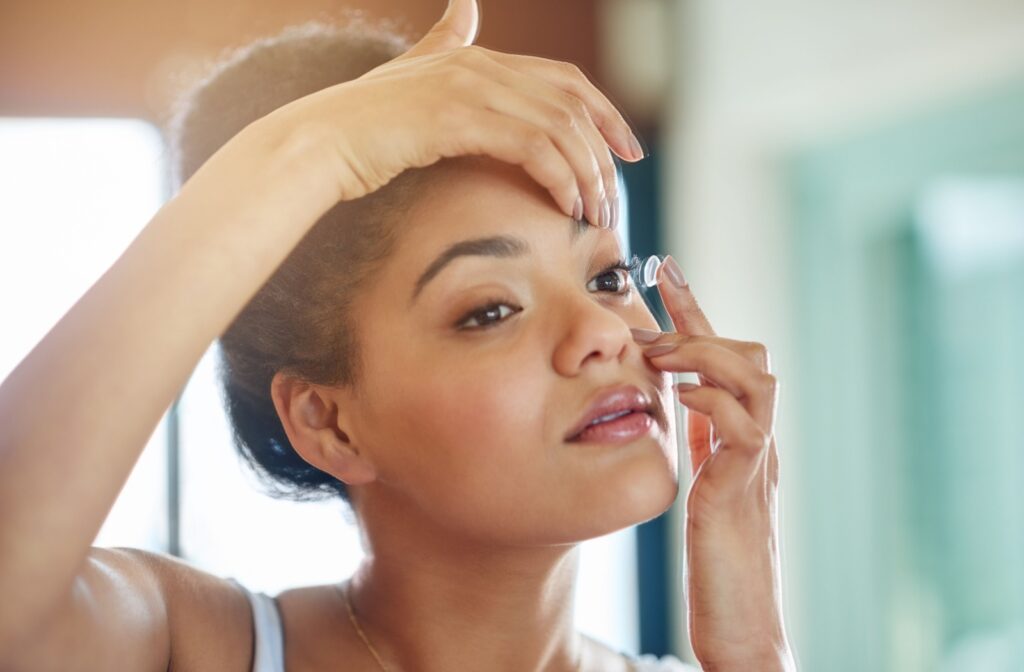Contact lenses are a convenient solution for vision correction, but they can come with consequences. People who wear contact lenses may be at higher risk of developing dry eyes. Fortunately, some types of contact lenses are more suitable for those with dry eyes. If you experience dry eye symptoms, there are also treatments and techniques available to help alleviate the discomfort.
About Dry Eye
Dry eye is a common condition that affects millions of Americans every year. It happens when the eye does not produce enough tears to lubricate it, or when the tears it does produce don’t work properly.
Symptoms of dry eye include:
- Feeling like there’s something stuck in your eye
- Scratchy, gritty, burning, or stinging sensation in your eye
- Heightened sensitivity to light
- Blurriness that comes and goes
- Redness in the eyes
What Causes Dry Eye?
There are many possible causes of dry eye, including:
- Environmental factors: Wind and smoke can lead to dry eyes, as do dry environments. Using a humidifier in a dry indoor environment may help with symptoms.
- Screen use: Looking at screens for prolonged periods means you blink less, which can lead to dry eyes.
- Laser eye surgery: Sometimes, dry eyes develop after some types of laser surgery.
- Medications: Drugs used to treat allergies, colds, hypertension, and depression may cause dry eyes as a side effect.
- Health conditions: Medical issues like diabetes, autoimmune disorders, and thyroid conditions are associated with dry eyes.
While anyone can develop dry eye, women, people over age 50, and people who wear contact lenses are at higher risk. People with certain medical conditions and those who are deficient in certain nutrients are also at higher risk.
Types of Contact Lenses for Dry Eyes
If you wear contact lenses, you’re probably aware of just how many contact lens types there are. Some types of contact lenses may be more comfortable for people with dry eyes.
Soft Contact Lenses
Generally, soft contact lenses are recommended for people with dry eyes. This type of contact lens is made of soft, pliable plastic that allows oxygen to pass through its surface. Often made from a hydrogel material, these contact lenses can also help lubricate the eyes.
Scleral Lenses
While soft contact lenses are often the recommended type for dry eyes, sometimes, an eye doctor will recommend a scleral lens. This is a type of hard lens, but it rests on the white part of the eye rather than the cornea. This means there’s a space between the lens and the cornea for tears to pool in, allowing for more lubrication.
Daily Disposable Lenses
There is some evidence to suggest that daily disposable lenses can be helpful to dry eyes. That’s because protein deposits—which can cause dryness and irritation—are less likely to collect behind these types of lenses.
However, daily disposable lenses are often made of silicone hydrogels, which tend to dry out fast and may not be suitable for everyone. It’s best to talk to an eye doctor about your particular case to find what works best for you.
Other Dry Eye Solutions

Depending on the cause of your dry eye, you may have other treatments or solutions available.
Dry Eye Treatments
Common interventions for dry eye include:
- Lifestyle and environmental changes: If the cause is environmental, avoid smoky, windy, and air-conditioned, dry areas. Try using a humidifier or using wraparound sunglasses when outdoors. Minimizing screen time, staying hydrated, and getting adequate sleep may also help.
- Lubricating eye drops: Artificial tears can be bought over-the-counter. There are also gels and ointments available over-the-counter.
- Prescription medications: In some cases, an eye doctor may prescribe medicated eye drops to help relieve symptoms.
- Other interventions: Further treatments include tear duct plugs called punctal plugs that prevent your tears from draining too quickly. Surgery can be used in more uncommon cases.
Contact Lens Care
The way you clean your contact lenses may also affect dry eye symptoms. For instance, the preservatives used in a cleaning solution may be irritating to some people. Talk to your eye doctor about cleaning solution options if you believe this is the problem.
Other hygiene pointers to keep in mind:
- Always wash (with soap) and dry your hands before handling your contact lenses
- Clean your lenses and case with fresh solution, not water, as water may contain bacteria
- Never sleep in your contact lenses
- Replace contact lens cases at least every 3 months
Dry Eye Therapy in Vancouver, WA
While dry eyes can feel like a simple problem, it can quickly get in the way of work, school, life, and play. If left untreated, dry eye may also lead to cornea damage. You deserve to see clearly and comfortably, so if you experience symptoms of dry eye, talk to an optometrist.
At Precision Eye Care, we’ll investigate the root cause of your dry eyes and then explore treatment options to help relieve you of bothersome symptoms. These treatments may include artificial tears or lifestyle changes. But we also have other treatments available, including intense pulsed light (IPL) therapy and radiofrequency (RF) therapy.
To learn more about contact lens fittings and dry eye therapy in Vancouver, WA, contact us today.





